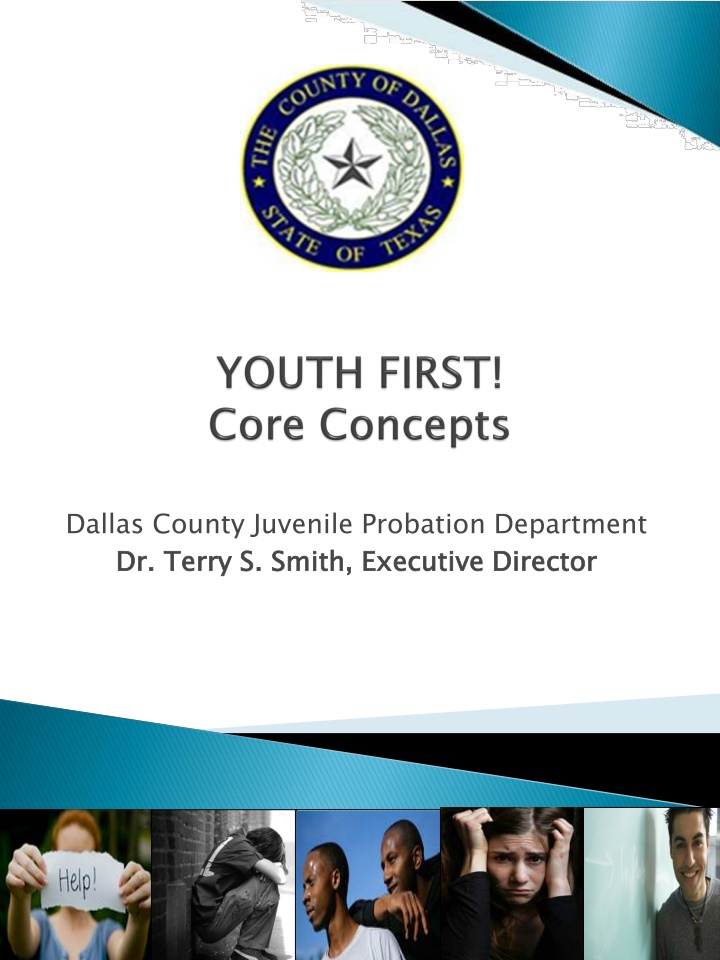
Innovative Approaches in Juvenile Probation for Positive Youth Development
The Dallas County Juvenile Probation Department under the leadership of Dr. Terry S. Smith implements programs focusing on reducing Disproportionate Minority Contact (DMC) and promoting positive change in youth. Emphasizing dignity, respect, boundaries, and engaged supervision, the department aims to create a safe and rehabilitative environment. Staff play a crucial role in setting high expectations and establishing healthy boundaries with youth. The key to success lies in treating youth with respect, intervening when needed, and fostering positive relationships to rebuild self-esteem.
Download Presentation

Please find below an Image/Link to download the presentation.
The content on the website is provided AS IS for your information and personal use only. It may not be sold, licensed, or shared on other websites without obtaining consent from the author. If you encounter any issues during the download, it is possible that the publisher has removed the file from their server.
You are allowed to download the files provided on this website for personal or commercial use, subject to the condition that they are used lawfully. All files are the property of their respective owners.
The content on the website is provided AS IS for your information and personal use only. It may not be sold, licensed, or shared on other websites without obtaining consent from the author.
E N D
Presentation Transcript
Dallas County Juvenile Probation Department Dr. Terry S. Smith, Executive Director Dr. Terry S. Smith, Executive Director 1
Reduce DMC First Time Offender Programs Educational Advocacy Program Buy-In Climate of Culture Evening Reporting Center Shift in Paradigm YOUTH FIRST! Interns/Mentors/ Volunteer/ Bilingual Staff Community Partners Program Addressing Family Dynamics Peer Advisory Council 2
Change Change Dignity & Respect Organization & Consistency Boundaries/ Engaged Supervision Therapy, Programs & Rehabilitation Safe Environment 3
1. Dignity and Respect 2. Boundaries and Engaged Supervision 3. Safe Environment 4. Organization and Consistency 5. Therapy, Program and Rehabilitation 4
Biggest key to change and success Treating youth and families with dignity and respect at all times Setting high levels of expectations Intervening with youth who are disrespectful Teaching youth that the more respect they show others, the more they will reap for themselves 5
Staff must be the front line for youth Boundaries may include: Physical Emotional Mental Providing immediate feedback for inappropriate behaviors Provide alternative behavior choices Should be professionally established Warning signs of unhealthy boundaries include: Sharing personal information Too involved with family Intimate information about themselves/relationships Trying to save the youth and intervene in sanctions Defending youth although violated policy, procedure and/or probation. Engaged supervision (alert) 6
Comprehension and buy into mission statement, interactions with youth Demonstrate same tone of respectfulness and high expectations Strive to develop and maintain relationships Youth, administration, community partners, vendors and education collaborators Connections are necessary to instill the rebuilding of self-esteem and personal worth among our youth 7
Cleanliness and order Programming Living and sleeping areas Building in general Youth participate in life skills Landscaping, community service, other projects In order to convey responsibility for environment Being consistent with policy and limits, allow youth to complete expectations and achieve goals Youth are aware that the rules do not change based on daily interactions Enforce the rules of the Court consistently 8
Maintaining a positive atmosphere within treatment groups requires continuous supervision by knowledgeable dedicated staff Possess the facilitation skills needed to de- escalate tensions using each situation as an opportunity to assist youth to explore behaviors and provide options Focus on personal growth is constant All Staff are to be considered treatment staff 9
Rehabilitation To restore to useful life, as through therapy and education or To restore to good condition, operation, or capacity. * child savers to child law advocators to child crusaders back to child savers with a strong emphasis on therapeutic rehabilitation Main goal: prevent re-offending and allow child successful reintegration Rehabilitation spending far exceeds Ivy League education Justified less than needed outcomes and abusive living conditions, in the guise of rehabilitating youth *Source: Wikipedia 10
Therapy Therapeutic treatment especially of bodily, mental, or behavioral disorder Establishing strong foundations for success basic values Approval Acceptance Achievement Attachment Provide therapeutic intervention to challenge young people and change attitudes, beliefs and behaviors Change comes from internal choice of young people Engaging in treatment Consider new directions 11
The support for legislative matters as it references juveniles, including sending agreement letters, discussions in Austin and with legislative personnel; Having the Board support or not support legislature that is conflicting to the best interest of the juvenile justice system; Assist us in meetings with collaborative law enforcement agencies to address DMC; Continue to inform the community of the issues as it relates to our specialty populations, i.e.; juvenile mental health issues; girls in trafficking; GLBTQ youth; Supporting funding/grant endeavors or opportunities, using CJAB as a partner; Assist Juvenile Probation in establishing community partnerships focused on reducing delinquent activity; Partner with Juvenile Probation to establish a YOUTHFIRST Initiative (fundamentally, community forums with us, community partners and law enforcement to concentrate on delinquent behaviors and community reintegration. Community Partners Program 12
